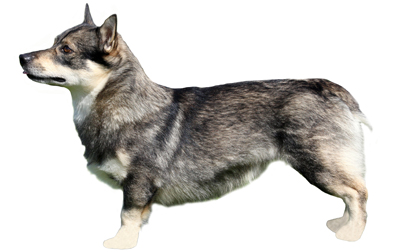Swedish Vallhund Breed Guide

Breed Group:
Herding Dogs
Get 30% off
Join our Newsletter
Sign Up Today
Swedish Vallhund Background Information & History
A champion on the farm as well as in the show ring, the Swedish Vallhund is a versatile dog that can handle any task. Known for herding as well as hunting, these dogs served as an excellent ranch hand throughout Scandinavia for many centuries.
For most of their existence, the Swedish Vallhund stayed in their native lands and just recently expanded to the United States. Although they have gained little popularity ever since their endearing characteristics make them the perfect match for any family.
Swedish Vallhund Temperament & Personality
Alert and loyal, the Swedish Vallhund is an active breed that loves to be around their family. These companions also serve as excellent watchdogs and will alert their owners if they feel even the slightest bit threatened.
When talking about the Swedish Vallhund, it’s also important to mention that they have a stubborn streak as well. While this trait can be managed, it is something the pet owner should be aware of before bringing them home. At the end of the day, this breed works best in an active and loving household that can give them lots of attention.
Swedish Vallhund Training Tips
As previously stated, Swedish Vallhunds need a little extra work when it comes to training. They’re independent thinkers and won’t want to do anything that doesn’t interest them from the very beginning. That’s why it’s important to start the canine training process as young as possible and keep the lessons entertaining with games and incentives.
It is also important to socialize your dog with different people, places, sounds, and experiences so he becomes a well-behaved pet later on in life. If you are still having difficulty training your Swedish Vallhund, try enrolling him in a puppy training course for extra support.
Swedish Vallhund Exercise Needs
Before bringing home a Swedish Vallhund, make sure you can handle their high activity levels. A quick walk around the block or a little running in the backyard will not be enough for these playful pups.
The Swedish Vallhund should exercise for at least 30 minutes to an hour every single day, and also get plenty of attention while they are in the home. Whether its agility, hiking, tracking, or obedience training, these dogs prefer a variety of activities and will do them exceptionally well.
Swedish Vallhund Lifespan
The average lifespan of the Swedish Vallhund breed is between 12 to 15 years old.
Swedish Vallhund Breed Popularity
The Swedish Vallhund is ranked as the 163rd most popular breed out of 202 registered breeds by the American Kennel Club.
Swedish Vallhund Feeding Requirements
A Swedish Vallhund should consume between 1 to 1 ½ cups of high-quality food a day, split into two equal meals. Keep in mind, this amount may vary depending on your individual dog. Factors to consider before creating a specific feeding regimen for your Swedish Vallhund should include his size, age, activity level, and metabolism.
Swedish Vallhund Grooming
The thick, double coat of the Swedish Vallhund should be brushed at least once a week to maintain optimal health. Weekly brushing will also help to distribute natural oils throughout the dog’s coat. Aside from canine coat grooming, your pups nails should be trimmed every couple of weeks and his teeth should be brushed once a week to prevent tartar from building up. Lastly, be sure to check your pups ears, eyes, and nose for any signs of infection.
Are Swedish Vallhunds Good With Kids?
As long as your dog has been raised with children, he should have no problem coexisting in the same house. However, with that being said, the Swedish Vallhund breed are herders by instinct and may try to nip at your child’s feet if not properly trained.
Swedish Vallhund Health Problems
The Swedish Vallhund is a fairly healthy breed, but they are still prone to several health complications. These dog health problems may include:
Retinopathy: This inherited eye disease occurs when the retinal photoreceptors begin to deteriorate. In severe cases, retinopathy can lead to total blindness.
Hip Dysplasia: Hip Dysplasia in dogs is a common hereditary disease that affects almost all breeds. This occurs when the hip socket and thighbone no longer properly fit together, which causes pain, lameness, and even arthritis.
Other Resources
National Breed Website: Swedish Vallhund Club of America
Rescue: Swedish Vallhund Rescue
